International Students Flock to Japan's Only School of Sushi
CONTENTS
International Students Flock to Japan's Only Sushi School
By Ryoji Shimada, staff writer
"Now prepare and arrange the platter (14 sushi pieces and 2 hosomaki rolls) in 15 minutes!" At the sound of the cheerful order from senior instructor Ken Kawasumi, the 5 students set to work at once. Ian Valdivieso (age 27) is from Spain, and he starts off with the hosomaki. "I learned a little about nigirizushi (hand-formed sushi) and hosomaki rolls from a Japanese person I met in Hawaii," tells Ian as he spreads the sushi rice evenly onto the nori sheet that he has placed on the sunoko slatted wood board and places the long thin slices of cucumber garnish in the center with a practiced hand. Kawasumi has said that it is harder to make hosomaki (literally "long thin roll") than futomaki ("fat roll") but Valdivieso's creation is skillfull.
This school is the only place in Japan that trains sushi chefs. Established in Tokyo's Shinjuku in 2002, the Tokyo Sushi Academy (TSA) has already turned out 1,000 graduates. Ian is a student in TSA's 2-month course.
Besides Ian, there are 2 people from Korea and 2 from Japan in this course, which began on March 7. The 2 Japanese people actually came back to Japan from their lives overseas in order to study the art of sushi.
Most of the foreign students are in Japan on three-month tourist visas when they take the course, and they all seem to have different objectives.
Ian worked as a chef and in restaurant management for five years in Spain, up until last year at a Japanese restaurant in Spain, where he decided to take up the study of making sushi in earnest. "There are few Japanese chefs in Spain. We need people who can make sushi properly," said Ian.
After first stating that he doesn't really care for sushi much himself, Rockhun Kim (age 42) from Korea tells of his dream: "I was curious as to why sushi was so popular in Asia, in fact all over the world. In Korea the sushi culture is pretty well rooted, but so far there are no chain sushi shops. I want to develop an izakaya pub style restaurant chain that offers mainly sushi."
From Shenyang in China comes Wei Fang Bin (age 29) who has been living in Japan for 9 years after marrying a Japanese woman. He says, "After finishing my studies here, I want to go back to China and within 3 years plan to have my own sushi shop." Wei became a sushi lover after first tasting it in Japan. He thinks that "Now is the time if you want to start a business to catch the wave of sushi's popularity in China."
Wei's analysis is on target. According to a JETRO report (February 2011), the number of Japanese restaurants in Shenyang has grown drastically over the past year or two, and there are now about 100 Japanese restaurants, mainly sushi, teppanyaki grill and ramen noodle shops. "As an increasing number of consumers begin to value a spiritual and psychological abundance instead of economic richness, we see heightened aspiration for an upscale element as well as authenticity in foods" (JETRO report). This seems to have created a greater need for authentic Japanese sushi.
Wei is in the middle of a one-year course that he started in April. All together he is spending upwards of 1.5 million yen including tuition, materials cost and uniforms. This was not an amount that came easily to hand for this student. Living on what he earns working 4 days a week at an izakaya pub restaurant, Wei says he used his savings to pay for school, without asking his parents for anything.
The Flow of Making Sushi
Difficulties Making Sushi and Course Variations
What is the most important thing to know about making sushi? We found out something unexpected when talking to TSA staff. It is to spend a sufficient amount of time after class cleaning the workstation and sharpening knives. After the class we observed the students spent about one hour doing cleanup. A TSA spokesperson says, “Hygiene and sanitation control are extremely important because food is being handled.” Wei agrees, "Food preservation is the most difficult part of making sushi. Practicing proper sanitation and not letting fish go bad while allowing it to rest before slicing it for sushi in order to get the best flavor out of it is not easy."
TSA offers a variety of courses, but the standard ones are either the one year sushi chef course that Wei is taking, or the 2 month certificate course (called the diploma course) that Ian and Rockhun are enrolled in. The certificate course is also offered in English, with an interpreter helping instructor and students communicate. The text and notes on the board are also written in English. For the Japanese students who have dreams of working overseas, it is a great way to study English.
There is an admissions exam, and not just anyone is accepted into the program. “When they are applying from overseas, we do the interview by Skype. Anyone who shows any kind of mental instability when it comes to handling knives is rejected out of hand,” tells the TSA spokesperson. Most of the students applying from overseas are experienced chefs, but she told even people with no experience can be accepted as long as they have a strong desire to learn and sufficient awareness of their goals.
Sushi Chefs in Short Supply
According to Ken Kawasumi, “Some of the sushi chains have a corporate sushi school within the organization, but TSA is the only sushi school open to the public (in Japan).” He tells, “The apprentice system is still prevalent in the independently owned sushi shops, and it’s not unusual for someone to spend the first three years cleaning the floors. Gradually he will be allowed to mold some sushi rice, and after about ten years he may make his first dish for a customer.”
In that case it may be no wonder that there is an increasingly small number of young people that want to become sushi chefs. Tom Horiguchi, TSA public relations manager, says “Japan’s sushi industry is desperate for people.” TSA president Makoto Fukue was a management consultant when he founded TSA with that fact in mind back in 2002. TSA added the certificate course conducted in English in 2009 in response to the many inquiries from overseas. Horiguchi tells that students come from all over including Europe, Russia, America and the MidEast.
According to student Ian, there are a lot of Japanese restaurants in Spain but most of them are run by Chinese people and there are hardly any Japanese chefs. Ian says that he wanted to learn the authentic sushi technique in Japan, since there is a need for people who know how to make sushi properly. Kawasumi says he is “happy if they just learn the fundamentals of sushi for now,” but in fact he is sometimes impressed by the unique styling of their plating arrangements. “They might be cutting the cucumber into shark jaw shapes, or cutting the grass decoration into the shape of a cat – sometimes I say, pardon me while I steal that idea!”
Unique concepts like these come up with by foreigners have served to broaden the appeal and potential of sushi, such as the California roll that adds mayonnaise to avocado and crab, or the French roll called Salmon Fromage that combines salmon and cheese. Ian plans to visit Thailand and Vietnam after he finishes at Tokyo Sushi Academy, in order to learn more about Asian cuisine. He seems to be seeking ways to satisfy the sophisticated palates of customers with a fusion of Asian and European or American cuisines. He says, “I have worked at five-star hotels, but when we had some rich Americans come in as guests, they weren’t satisfied because we weren’t serving them any kind of sushi that they were unable to get at home.”
Apparently in Spain sushi became popular among young people first, imitating certain entertainer personalities, and now there is a kind of sushi boom all over Spain. But young people grow bored easily and Ian is looking to a future when “everyone is bored with eating just maguro (tuna fish) and salmon, so we will have to give them something new.”
The 14-piece and 2 hosomaki roll plate that Ian made in class is rated by Kawasumi at a slight discount from 2,000 yen, which is what the value of the plate created by instructor Kawasumi is set at. Kawasumi asks for a 200-yen discount on Ian’s plate, so his final score is 1,800 yen, in this unique grading system.
How much would this plate cost if offered in Spain? “At least 40 or 50 euros,” tells Ian. “Since there are hardly any people who can make proper sushi in Spain, (sushi chef) salaries are very very good.”
After the 3.11 earthquake disaster, most of the foreign students went back home, having a major impact on Tokyo Sushi Academy. But every year more and more students apply, and in fact for the one-year course that will start this October there are enough students to split the group into two classes, in order to meet the rising demand.

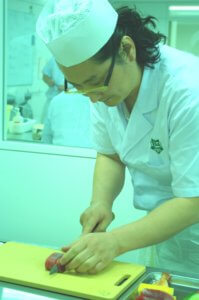
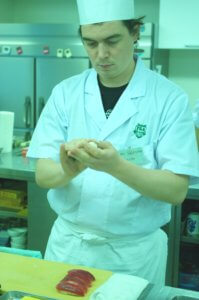

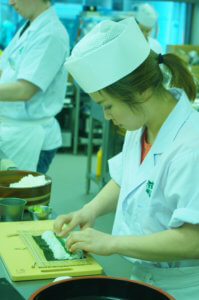

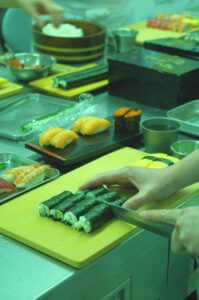
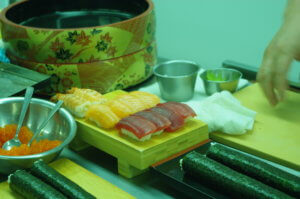

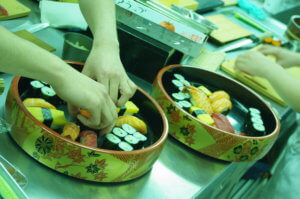
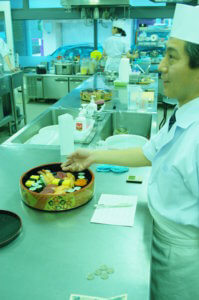
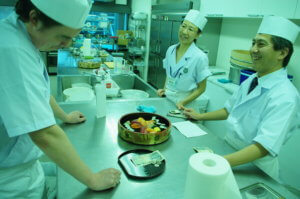


One thought on “International Students Flock to Japan's Only School of Sushi”